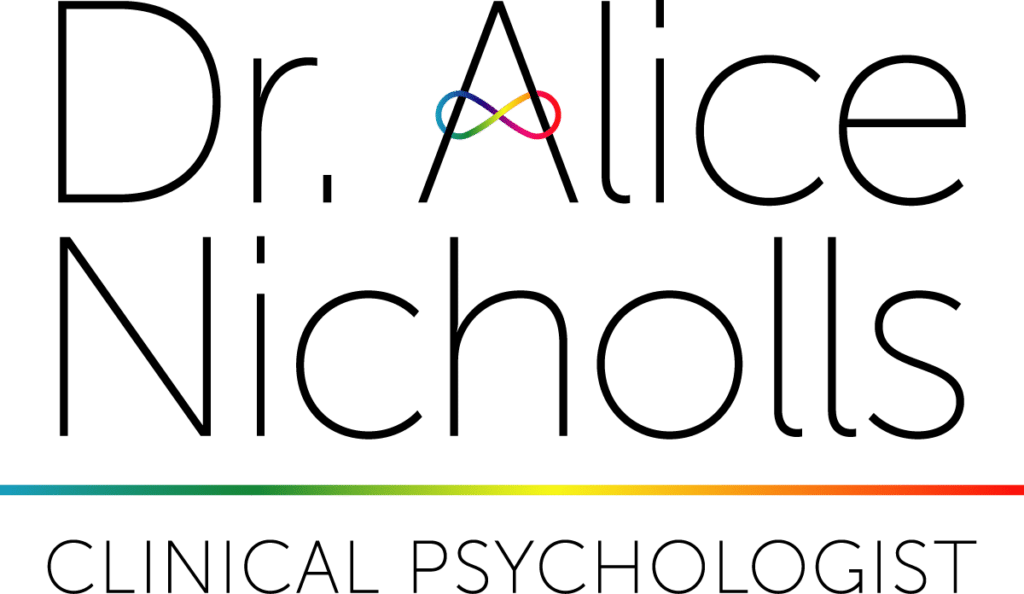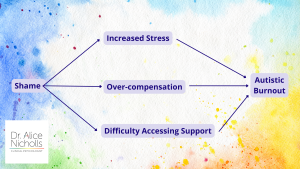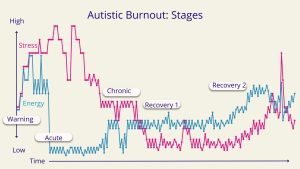‘Avoidance’ has become a bit of a dirty word when we talk about stressful situations, hard work, trauma or phobias.
While there are valid reasons for having concerns about avoidance, it isn’t always a bad thing.
Sometimes some degree of avoidance of stressful or triggering situations is an important part of recovery from chronic stress and this is particularly true if you are experiencing Autistic Burnout.
In this article I will explain:
- Why avoidance has a bad reputation
- The problem with avoiding avoidance in general
- The problem with avoiding avoidance in Autistic Burnout
- How to decide whether or not it will be helpful to avoid stressful situations or triggers
1. Why avoidance has a bad reputation
If you’ve ever had any Cognitive Behavioural Therapy (CBT) for anxiety you will have probably been told that avoidance increases anxiety, you will have been told to feel the fear and do it anyway or you might have been encouraged to gradually expose yourself to more and more of the thing that is causing you anxiety.
The theory here is that avoidance maintains anxiety. So if you had a difficult experience that has triggered anxiety about a specific event or behaviour and led to avoidance of that event or behaviour you won’t have the opportunity for your body to learn that you can feel safe in similar situations and your anxiety about that event or behaviour will be maintained.
This is a very helpful psychological mechanism when the bad experience is something that will always cause you harm, for example if I put my hand in a fire and get burnt, I will feel anxious about doing it again and I will avoid doing it again.
The avoidance maintains my anxiety but this actualy keeps me safe.
It can cause problems when the trigger for the anxiety is a low frequency event such as a car crash, falling a horse or being present in the wrong place when a lion escapes from the zoo.
While these events are unlikely to happen again, the stress they caused at the time is likely to trigger an avoidance response: You are likely to struggle with anxiety when considering getting back in the car, back on the horse or visiting wherever you were when you came into contact with the lion.
Cognitive Behaviour Therapy for the avoidance seen with this type of anxiety would typically include gradually exposing you to the stressful (but not dangerous) situation at a level that felt manageable, keeping your level of anxiety at a medium- low level.
Exactly what this would involve would depend you and your own specific situation and level of anxiety, but for examples sake, in the case of the car crash, might start with sitting in the stationary car, or driving around the block with a friend, or in extreme situations just imagining doing these steps.
Given the treatment of choice (at least for UK NHS patients) for avoidance, in the context of an anxiety disorder, is graded exposure accompanied by cognitive therapy it makes sense that some of this has filtered into our daily language. For example:
- “feel the fear and do it anyway”
- “it’s never as bad as you think it’s going to be”
- “You’ll feel better once its done”
- “Get straight back on the horse’”
All of this advice stems from this idea that we need to be exposed to situations we feel unsafe in, in order to learn that we can be safe in them.
2. The Problems with avoiding avoidance
You need to be regulated before addressing avoidance
I have purposefully given you two extreme examples above, one where avoidance is entirely functional, protecting you from harm (putting your hand in the fire) and another where the avoidance is likely to result in disruption, loss of quality of life and (probably) without protecting you from harm (not getting in the car).
There is an implicit assumption that, even in the example of the car crash, that your baseline level of stress and anxiety is relatively low. That is, you feel regulated before you start thinking about getting in a car again, or at least you are able to engage in regulating, or grounding exercises that enable you to reach a state of calm before you start to very gradually address the triggers for your anxiety.
This means that if your life is highly stressful you might not be in the best position to start addressing avoidance and most therapies for trauma acknowledge that by providing a period of stabilisation before working through the actual trauma.
Depending on the stress levels in your life at the time there needs to be a careful cost benefit analysis of whether leaving the trauma untreated is better or worse for you than the avoidance and the potential impact of that avoidance on your safety and quality of life.
Sometimes it really isn’t safe
When someone is avoiding something there is often an assumption that it is because they have some kind of anxiety disorder that would repond to graded exposure. The reality is that sometimes we are avoiding something because it’s actually not safe for us. What is and isn’t safe for us depends on our own personal risk factors which can include things that we know are likey to cause us a lot of stress and may push us over the edge into Autistic Burnout.
For Autistic people these are often things that might be dismissed by other people like for example public speaking, having building work done on your home visiting the supermarket or travelling on a crowded train at rush hour.
Safety isn’t a binary variable
I purposefully used extreme examples in the section above, so the feared activities were low frequency and therefore the chances of having a repeat bad experience were minimal. It is rarely as clear cut as this. Activities such as BASE jumping, boxing, motorsports or eating oysters have risks associated with them. You need to personally decide how much risk you are prepared to expose yourself to.
It may not be a priority right now
“I have a long standing snake phobia, I know it is treatable but I also know it would take time, energy and commitment and given I live in the UK where we barely have snakes this phobia does not limit or restrict me outside of avoiding the reptile house when we visit the zoo”
The example above illustrates how sometimes maintaining anxiety about specific things isn’t a massive issue in terms of our day to day quality of life and might not make it to the top of your priority list.
Your avoidance might have nothing to do with anxiety
We are so used to talking about avoidance in the context of trauma, phobias and anxiety that we forget there are other reasons you might be avoiding something. You might be avoiding a situation, event or person for many reasons including but not limited to:
- You don’t like it/them : This is a valid reason for not doing something. Often other people find this difficult to understand if it is something they like, For example: eating out, meeting up with a group of people, attending meetings at school/work etc.
- You don’t have the energy: Our energy (be it physical, social, cognitive, emotional or sensory) is a finite resource meaning we have to prioritse the essentials and our personal preferences first.
- You would rather be doing something else with that time/money/energy: Avoiding something might actually be enabling you to engage with something else that is more important or useful to you.
3. The problem with avoiding avoidance in Autistic Burnout
Far too often, when you reach Autistic Burnout, you have been pushing yourself outside of your ‘comfort zone’ for so long you don’t even know what your comfort zone looks or feels like. You have become used to experiencing high levels of stress and anxiety for far too long.
You may be so used to being uncomfortable, you don’t even know how uncomfortable you’ve been and for how long.
You might have stopped listening to the signals from your mind and body trying to tell you that something is too stressful for you.
You might have entirely lost contact with those signals (afterall if they’re always considered ‘wrong’ or to be ignored, what’s the point in even having them?)
This may have been perpetuated by the belief or instruction that if you just try a bit harder, ride it out, or feel the fear and do it anyway your stress and anxiety levels will eventually decrease and life will get easier.
As an Autistic person, if you have internalised the belief that ‘avoidance is bad’ you might find it aversive to actually avoid something.
The idea of avoidance can spark feelings of fear, shame and failure.
However, being continually exposed to stressful, overwhelming and anxiety provoking situations, without adequete time spent recovering, relaxing and regulating yourself is likely to cause and maintain Autistic Burnout.
You need to feel safe.
Feeling safe is not a bad thing.
Feeling safe allows us to rest, reconnect with ourselves and with others and start to replenish our energy levels and health in general.
There is often a concern that in order to feel safe and regulated Autistic people might need to make their world/ range of experiences very small and narrow and then be even more reluctant to get out of their comfort zone.
In reality, if you are in Autistic Burnout and your comfort zone is completely alien to you, then yes, you probably do need to spend some serious time discovering it and familiarising yourself with it. You probably need an extended period of feeling relatively safe.
When you are feeling safe, regulated and replenished, then you will start to identify some things you want to gradually stop avoiding, either because they are aligned with your values or because you know it would be wise for you and for your future wellbeing. When you are ready to do it from a position of safety and regulation, you can gradually decrease some of your avoidance.
4. How to decide whether or not to avoid
I appreciate the amount you can choose to avoid stressful situations varies considerably depending on your own personal situation and values.
Recovery is (almost) never as simple as cutting out all of the stressors in your life, for many of my clients just working out how and where they can reduce stressors is a large part of the work we do together.
You can help determine whether avoidance is a helpful strategy by asking yourself some of the following questions:
- Do I want to do it?
- What would happen if I didn’t do it?
- How bad would it be?
- Would the consequences of avoiding be worse that the consequences of doing it?
- If I avoided this would it mean I gave my self some time, space or energy for something else that is more important to me? (and yes this could be rest!)
- Am I avoiding this activity because of anxiety?
- Is avoiding it likely to make the anxiety worse for me next time?
- Is that increased level of anxiety likely to damage my quality of life?
- Does this avoidance make it hard for me to perform basic self care tasks?
- Is this avoidance hurting my health? (e.g. seeing the GP for a health issue that needs to be resolved)
You don’t have to ask yourself all of these questions, they are intended to be used as prompts to challenge whether avoiding avoidance is on balance, more likely to be helpful or harmful and aide your decision making process.
Summary
Avoidance of anxiety provoking activities, events and people can, in some ways, maintain your anxiety and make it as difficult or more difficult to engage in the future.
Despite this potential pitfall avoidance can be a wise choice when you are too stressed and dysregulated to cope with an increase in anxiety.
Addressing anxiety based avoidance needs to be done carefully, when it is a priority and ideally when you are rested and regulated.
This means that unless your anxiety is significantly limiting your life and your ability to recover from Autistic Burnout avoidance may be a useful tool for surviving even when the avoidance is anxiety based.
Avoidance can be misinterpreted as evidence of an anxiety disorder in Autistic adults who may be avoiding situations, people and events that are stressful, genuinely dangerous or require too much energy.
The concept of avoidance can induce feelings of shame, fear and anxiety, particularly if you have previously had your avoidance mistakenly interpreted as an anxiety disorder.
Often Autistic people have been too stressed for too long and need to significantly reduce the stressors in their lives in order to feel safe, rest and regulate. Avoidance can be a useful tool to enable this.
If you use avoidance to help you to reduce your exposure to stressors it is normal to feel some fear about whether you will be able to decrease your level of avoidance in the future.
When you are able to rest, regulate and start to feel more replenished you can start to consider which of the stressors in your life are important to/for you and think about sustainable ways of slowly and gently reintroducing things that are priorities for you.
I am an Autistic Clinical Psychologist specialising in Autistic Burnout if you would like to know more about my work please check out my:
- Mailing list community for people who want to receive helpful information and resources about Autistic Burnout.
- Free short course on How to Break the Cycle of Autistic Burnout (link goes straight to registration page)
- Authenticity Basecamp: A 90 day support programme for people in the early stages of recovering from Autistic Burnout who want to get calmer, clearer and more supported.
- Authenticity: The Course and Community: For late-realised, high-masking Autistic adults who want to build more sustainable, authentic lives and break free of the cycle of Autistic Burnout for good.











